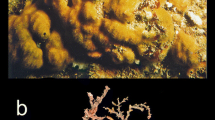Abstract
Samuraia tabularasa, the samurai hydroid, a previously unreported genus and species of athecate hydrozoan, family Hydrocorynidae, is described, based upon field and laboratory observations. Colonies live attached to rocky substrates in the middle of the intertidal zone in the northern and central Gulf of California, Mexico. The principal characters that allow this species to be referred to a new genus are associated with its mode of sexual reproduction by eumedusoids that can remain attached to the colony, or be released as ephemeral, rudimentary structures. This is in contrast to the feeding, free medusae produced by the two species of the other genus, Hydrocoryne, in the family Hydrocorynidae.
Similar content being viewed by others
References
Bigelow, H. B., 1909. The Medusae. Reports on the scientific results of the expedition... by the U.S. Fish Commission steamer ‘Albatross’. Mem. Mus. comp. Zool. Harv. 37: 1–243.
Bouillon, J., 1985. Essai de classification des hydropolypeshydroméduses (Hydrozoa-Cnidaria). Indo-Malayan Zool. 1: 29–243.
Brinckmann-Voss, A., 1970. Anthomedusae/Athecata (Hydrozoa, Cnidaria) of the Mediterranean. Part I Capitata. Fauna Flora Golfo Napoli 39: 1–96.
Johnston, G. J., 1836. A catalogue of the zoophytes of Berwickshire. Hist. Berwicksh. Nat. Club 1: 107–108.
Kubota, S., 1988. Taxonomic study on Hydrocoryne miurensis (Hydrozoa: Hydrocorynidae) in Japan. Publs Seto mar. biol. Lab. 33: 1–18.
Kühn, A., 1913. Entwicklungsgeschichte und Verwandtschaftsbeziehungen der Hydrozoen. I Teil: Die Hydroiden. Ergebn. Fortschr. Zool. 4 (1–2): 1–284
Mangin, K. L., 1990. A pox on the rocks. Nat. Hist., N.Y. (June, 1990): 50–53.
Mangin, K. L., 1991. Community effects of the invasion of the samurai hydroid, a new intertidal barnacle predator. PhD thesis. Univ. of Arizona, Tucson.
Margulis, R. & A. G. Karlsen, 1980. A hydroid polyp Hydrocoryne, new for the fauna of the Sea of Japan. Zool. Zh. 59: 1248–1250 (in Russian with English summary).
Petersen, K. W., 1979. Development of coloniality in Hydrozoa. In G. Larwood & B. R. Rosen (eds), Biology and Systematics of Colonial Organisms. Academic Press, Lond.: 105–139.
Rees, J. T., C. Hand & C. Mills, 1976. The life-cycle of Hydrocoryne bodegensis, new species from California, and a comparison with Hydrocoryne miurensis from Japan. Wasmann J. Biol. 34: 108–118.
Rees, W. J., 1957. Evolutionary trends in the classification of capitate hydroids and medusae. Bull. Brit. Mus. nat. Hist. (Zool.) 4: 453–534.
Stechow, E., 1907. Neue japanische Athecata und Plumularidae aus der Sammlung Dr. Doflein. Zool. Anz. 32: 192–200.
Stechow, E., 1909. Hydroidpolypen der japanische Ostküste. I. Teil: Athecata und Plumularidae. Abh. bayer. Akad. Wiss., Suppl. Bd 1: 1–111.
Stechow, E., 1921. Neue Genera and Species von Hydrozoen und anderen Evertebraten. Arch. Naturgesch. (Abt. A, Heft 3) 87: 248–265.
Stefani, R., 1959. Sulla variabilità ecologica di un Idrozoo (Campanularia caliculata Hincks). Boll. Zool. 26 (2): 115–120.
Thomson, D. A., 1989. Tide calendar for the northern Gulf of California. University of Arizona, Tucson.
Toppe, O., 1910. Untersuchungen uber Bau und Funktion der Nesselzellen der Cnidarier. Zool. Jb. (Morph.) 29: 191–280.
Uchida, T., 1927. Studies on Japanese hydromedusae. I. Anthomedusae. J. Fac. Sci. Tokyo Univ. (Zool.) 1: 145–241.
Uchida, T., 1932. The medusa of Hydrocoryne miurensis Stechow, with a note on systematic position of the genus Cytaeis. Proc. imp. Acad. Japan 8 (4): 135–138.
Uchida, T. & Z. Nagao, 1967. The life-history of a Japanese hydroid, Hydrocoryne miurensis Stechow. J. Fac. Sci. Hokkaido Univ. (Ser. 6, Zool.) 16: 197–211.
Weill, R., 1934. Contribution à l'étude des cnidaires et de leurs nématocystes. I. Recherches sur les nématocystes. (Morphologie — physiologie — développement). II. Valeur taxonomique du cnidome. Trav. Stn zool. Wimereux 10: 1–347, 11: 347–701 (sic).
Author information
Authors and Affiliations
Rights and permissions
About this article
Cite this article
Mangin, K.L. Samuraia tabularasa gen. nov., sp. nov. (Cnidaria, Hydrozoa, Hydrocorynidae), an intertidal hydroid from the Gulf of California, Mexico. Hydrobiologia 216, 443–451 (1991). https://doi.org/10.1007/BF00026498
Issue Date:
DOI: https://doi.org/10.1007/BF00026498




